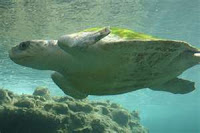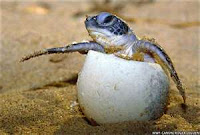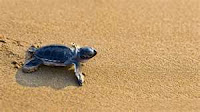The Pacific Olive Ridley, is one of only seven sea turtle species in the world and was named after The English botanist and geologist Henry Nicholas Ridley, They typically measure around two feet long and weigh between 70 and 100 pounds. A small head, large and heart-shaped shells characterize this species, which also have clawed flippers. True to their name, adult Olive Ridleys are dark gray-green in color, though juveniles are mostly charcoal gray. Olive Ridleys are omnivores, feeding on crustaceans, fish, mollusks, and the occasional jellyfish. When food is scarce, they also eat algae. Their life span is estimated between 50-60 years in the wild. While both sexes appear similar, males can be distinguished from female Olive Ridleys by their long tails, which stick out beyond their shells.
These turtles normally appear on the beach when the night is pitching black, they have the wisdom of the edges imprinted in their DNA, and they always know when the beach is the right beach to deposit their eggs.
Once they know they are in the right place, the female turtle start to dig with her rear flippers in a paddle-like motion; she digs as deep as she can and then after she positions her back side over the hole, she begins to expel the flexible, white, leathery spheres of the size and shape of a golf ball.
Once she has deposited all the eggs in the whole, she starts scooping the sand back into the whole covering her precious eggs; she knows that by doing that she will assure the future of her species.
Her ritual is not over yet, and it is fascinating; after she covers the eggs with sand, she places her hard bony under plate over the mound of sand, and using her flippers, rises her heavy body into the air and quickly let it fall with a reassuring thud, she repeats this exercise several times until the nest is firmly packed.
Of course the whole process is exhausting; but, her ritual is not complete yet, so she starts her labored journey back to the water’s edge, she stops frequently to rest, and then continues until she finally reaches the waves that will carry her into the ocean.
Marino Ballena National Park www.parquenacionalmarinoballena.co.cr located between Ojochal and Uvita; is very committed to preserve these wonderful creatures. During the months of August, September and October, the park rangers perform a night patrol in all the beaches from Playa Tortuga near Ojochal to Playa Hermosa near Dominicalito.
The objective is to stay one-step ahead the poachers; they are one of the reasons why the specie is diminishing in numbers. The park rangers on night patrol wait until the Olive Ridley Turtles to lay their eggs. Then, carefully withdraw them from the sand and take them to the Park Facilities where they have created some sort of Turtle Farm where they deposit the eggs in a whole covering them with well-packed sand just as the female Turtle would do it. This is a controlled environment for the soon to be baby Turtles. Their temporary home is covered with screen, preventing them from becoming a casualty trying to run to the water once they hatch. When the eggs have hatched, the park rangers take them to the beach and release them. This activity has to be done at night to minimize the casualties given the fact that they have too many natural predators.
Olive Ridley turtles can be seen laying their eggs on night visit to the beach between August and October. The largest numbers arrive on the waning moon usually in September.
You will be encouraged to not use unshielded flashlights, camera flashes, make loud noises, or approach too closely. The turtles have worked very hard to get to the beach, and do not scare them away.Marino Ballena closely monitors the visitors; however, make sure you do not get distracted or you may find yourself alone on the beach. Enjoy this amazing gift from Mother Nature next time you come to Costa Rica.






No comments:
Post a Comment